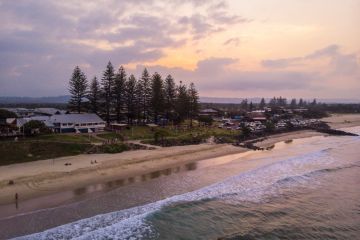Canberra's light rail could drive up property values along tram line
A number of suburbs set to reap the benefits of Canberra’s light rail route have already experienced a spike in value.
The ACT government’s Capital Metro line from Gungahlin Town Centre to the city is expected to drive more buyers to properties along the transport corridor and potentially boost home values, experts say.
This includes commercial real estate in the inner north, with the planned first route already enticing possible buyers and tenants.
Last month the ACT government signed the $710-million light rail contract with Pacific Partnerships-led consortium Canberra Metro to build and operate the tramline.
Harrison, Franklin, Watson and Downer have experienced a spike in their median home values since the business case for the project was approved by the government in 2014 – and they are set to record further growth.
The four suburbs are among those along the corridor furthest from the city and without major transport hubs, such as in Gungahlin or Dickson.
Harrison’s median house and unit value has surged by almost 40 per cent from $400,000 in 2014 to $557,000 in 2015. Six months into 2016 the median value is at $608,500, according to Allhomes data.
Similarly, Franklin’s median home value has increased from $409,000 in 2014 to $419,000 in 2015, sitting at $433,950 as of June, 2016.
By 2020 the suburb’s median is expected to hit $489,566, an almost 13 per cent jump in value, based on the compound annual growth rate drawn from the past four years.
Forecasting Harrison’s growth is more difficult due to fluctuating house prices over this period however, the same method places its median at $774,572 by 2018.
Both suburbs have undergone accelerating development in the past few years with a surge in the number of apartments built along Flemington Road.
Further south, Watson’s median has jumped 12 per cent from $545,000 in 2014 to $612,000 as of June, 2016. Downer’s median has also increased by 12 per cent from $607,500 to $680,000 over the same period.
Watson could jump to $816,502 in four years, while Downer could reach $867,470, based on the rate of compound annual growth.
Domain chief economist Andrew Wilson said the introduction of light rail would “absolutely” impact on the value of homes close to the public transport corridor.
While it was difficult to quantify the exact impact on house prices at this stage, he said the introduction of light rail would “only be positive for the local housing market”.
“You’re always likely to have an increase in buyers, rather than a decrease, in areas with high levels of transport infrastructure,” he said.
Dr Wilson cited the introduction of light rail in Western Sydney as a good comparison, describing it as a positive addition to a booming suburban area.
Allhomes data analyst Nicola Powell said improvements to public transport elsewhere had increased the value of nearby land.
While areas like Gungahlin did not experience the kind of congestion problems that hamper traffic flow in some other Australian cities like Sydney, light rail could push up prices.
“I do think we will see an increase in demand and that might translate to property price growth in that area,” she said
“Wherever the [tram] stops are, we’re likely see a flow-on effect in terms of the economic benefit and increasing demand for property in the area.”
Dr Powell expected increasing value around Flemington Road – home to four proposed tram stops –-if demand for property in the area kept pace with residential development.
She also expected the eventual sale of land in the new suburb of Kenny, east of Mitchell and next to the light rail route, to come with a hefty price tag.
JLL’s ACT Head of Sales and Investments, Michael Heather said although it was too early to analyse the sale price of commercial buildings along the light rail corridor – such as the $29.2 million sale of 73 Northbourne Avenue to a Melbourne investor in April – Capital Metro had piqued the interest of buyers.
The seven-storey building sold for $17 million in 2004, according to Allhomes data, representing a jump of almost $13 million over 12 years.
Details of CBRE’s sale of a large slice of prime real estate at 92 Northbourne Avenue, right on the Elouera Street tram stop, are imminent and the site should fetch more than $20 million.
Meanwhile, the developer behind Midtown this week described the light project as a “catalyst” for the mixed-use precinct, which will be located next to the Macarthur Avenue tram stop.
Further south, the relocation of ANU students from Fenner Hall in 2018, the same year stage one of the light rail project is expected to be completed, could open up a prime development opportunity.
“When dealing with Melbourne and Sydney-based groups, particularly because they see light rail or proposed light rail in their own cities, it is relevant and it is topical,” Mr Heather said.
“The general consensus is it will have a positive impact on the Canberra property market and values and future leases of office assets situated on the light rail route.”
Mr Heather said the city’s diminishing reliance on cars as a result of light rail could also spark a movement of workers from the city’s “fringe” areas, such as Deakin and Fyshwick, to Northbourne Avenue.
“Particularly as tenants come to the end of leases expiring in the next two to three years during first phase of the Capital Metro project,” he said.
“They may look at moving into city given the employee benefit of travelling to work via the public transport system produced by the light rail project.”
He expected private development to also accelerate near the light rail terminals, activating Northbourne Avenue at a street level.
Light rail has been a key policy among ACT Labor and the ACT Greens since the last territory election four years ago.
Construction is scheduled to begin midway through this year and trams are expected to begin taking passengers in early 2019.
The ACT Liberals have been strongly opposed to light rail, promising to scrap the project if elected to office after Canberrans head to the polls in October.
How we calculated the figures:
To forecast, we calculated the compound annual growth rate based on the median home value of each suburb over the past four years.
The compound annual growth rate looks at the average annual change over a set period of years to determine a steady rate of growth.
It’s important to keep in mind this is based on historical data and that values, such as home values, might fluctuate in the future.
We recommend
States
Capital Cities
Capital Cities - Rentals
Popular Areas
Allhomes
More







